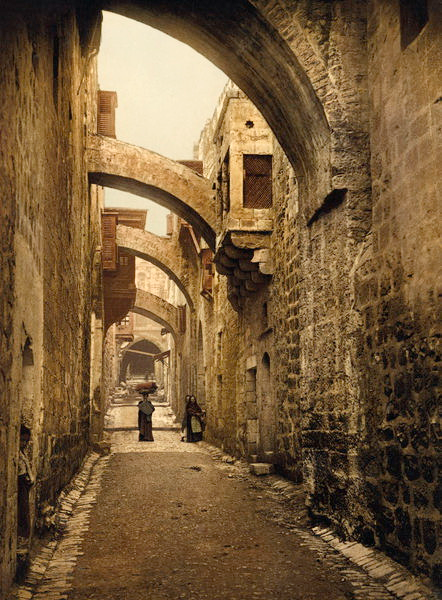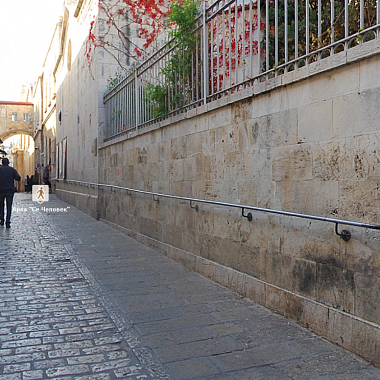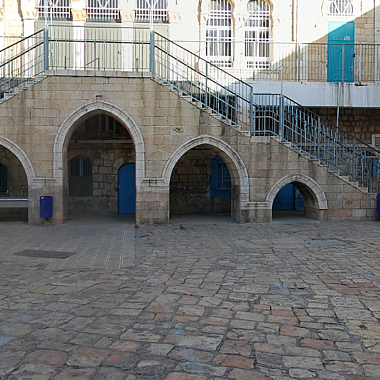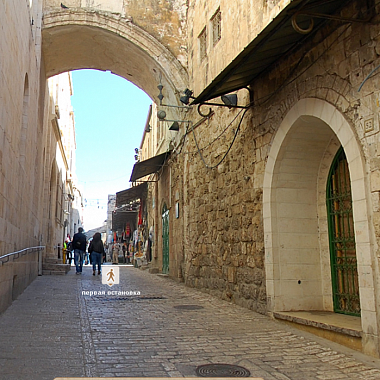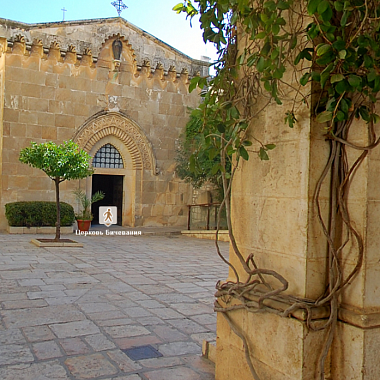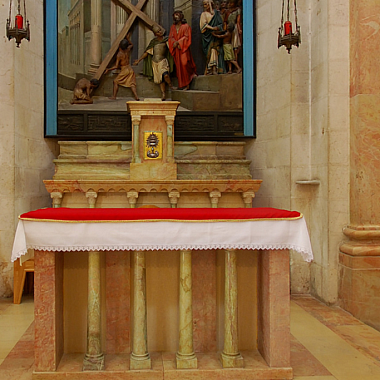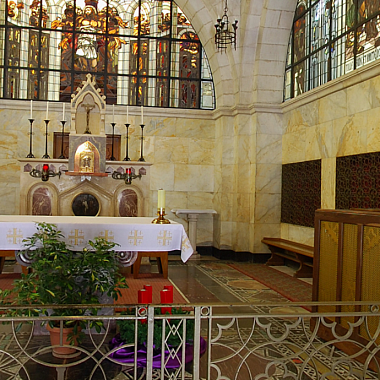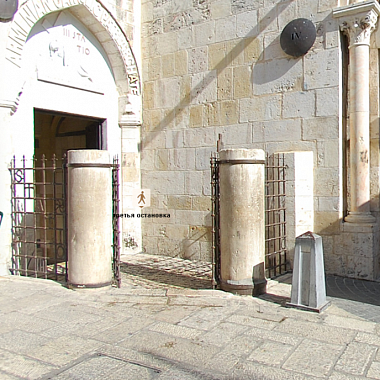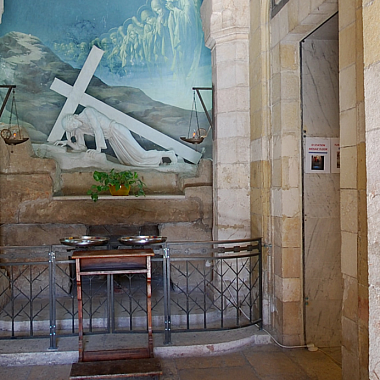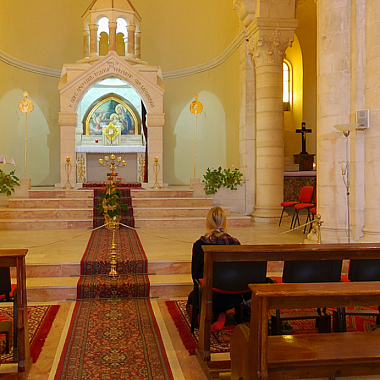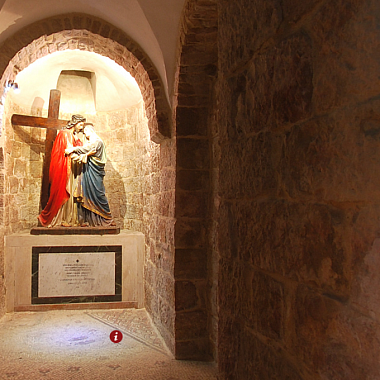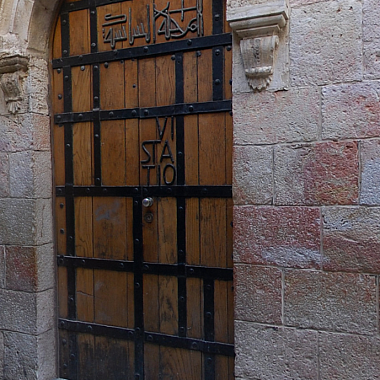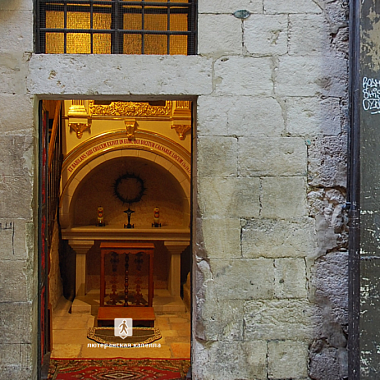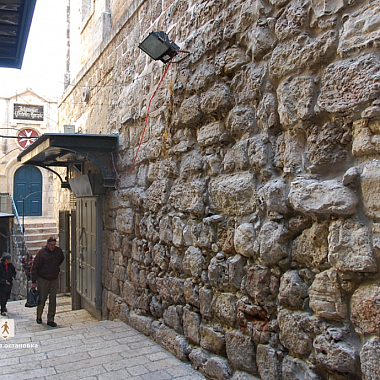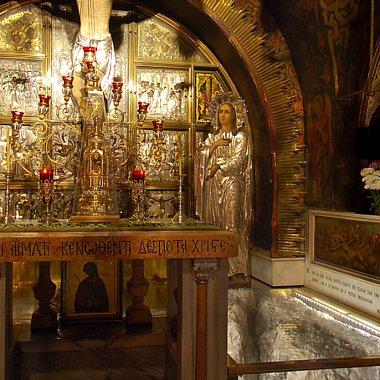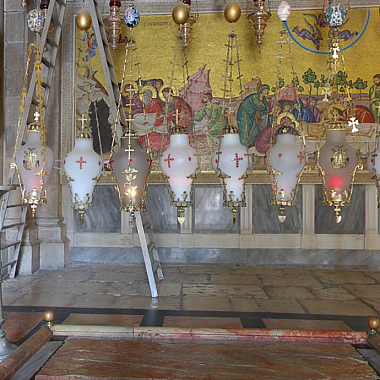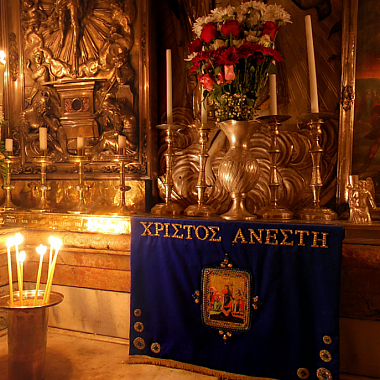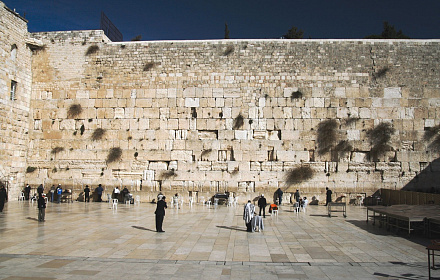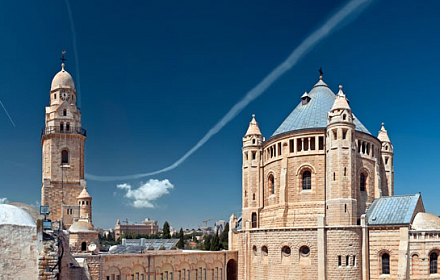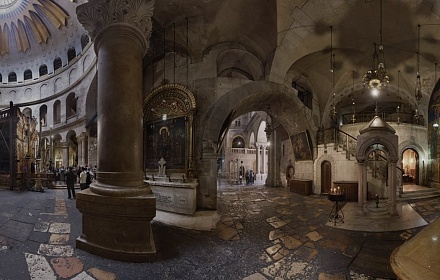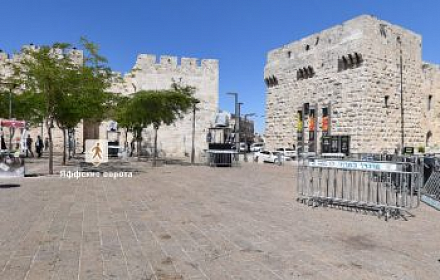About Virtual Tour
Introductory slide
Welcome to the virtual visit for one of the most important sites in Christianity, the Via Dolorosa! Also known as the Via Crucis, it is the route that the Savior took from the place where he was condemned to the site of his crucifixion on Golgotha. This final path was the site of various events that took place along the way of this sad procession. Today there are 14 official Stations of the Cross and all are marked by chapels or churches. Let's go on a virtual pilgrimageNine of the stations can be found in the evangelists’ accounts and the others come from Christian legends and traditions. The objective of this tradition and its spiritual essence relate to the attempt of the faithful to become familiar, at least in some small measure, with the suffering our Lord experienced while walking this path.
Millions of Christians from all over the world dream of visiting this site.
The place of Jesus’s trial
We are now at the first Station of the Cross at the place where Jesus was tried. The home of the Roman attorney for Judea was once here. Today, the Muslim Umariya school operates here.It was here that Pontius Pilate asked the masses: “What has this man done?” The people clamored: “Crucify him!” Then, the attorney set the criminal Barabbas free and condemned Jesus to death. This is where the Church of the Condemnation and Imposition of the Cross is located and it still has the slab floor from that time.
The Ecce Homo Arch of the Via Dolorosa is known as the place that Pontius Pilate took Jesus and said to the high priests: “Here is the man.” With those words the attorney wanted to say that the Son of Man was not guilty and deserved compassion.
This is explained in the Gospel of John 19.
The second Station of the Cross: Jesus is put on the cross. Today a large Franciscan church is located here, we are now in its patio. It was here that the Roman soldiers made a crown of thorns and put it on Jesus’s head. They placed a reddish-purple cloak over his shoulders to symbolize royalty and then mocked him, kneeling before him and saying: “Behold, the King of the Jews!” The soldiers spit on him and hit him on the head. This episode is mentioned in the Gospel of Matthew 27.
The Church of the Flagellation According to Roman Laws the condemned were to be whipped before crucifixion. Multiple executioners would hit them everywhere, and their whips were a flat strip with balls of bone or lead that caused excruciating pain when they hit Him. That is why the church that is here is called the Church of the Flagellation.
The Church of the Condemnation and Imposition of the Cross is part of the Franciscan church located at the second Station of the Cross. Its name comes from the fact that those condemned to death had to carry the cross themselves. They placed it over Christ’s shoulders and he carried it to Golgotha, the site of the crucifixion. Scientists have shown that the crosses used by the Romans weighed around 70 kg. At that time, Golgotha was outside of the urban limits of Jerusalem, behind the Judgement Gate on the western end of the city.
Jesus falls under the weight of the cross for the first time
The intersection of the Via Dolorosa and Gai Street marks two Stations of the Cross: the third represents the first time Christ fell under the weight of the cross, and the fourth represents Jesus’s encounter with his mother Maria.The Armenian Chapel and the Church of Our Lady of Sorrows are dedicated to this meeting. We invite you to visit them in our virtual visit.
We are at the third Station of the Cross where Jesus fell for the first time under the weight of the cross.
Jesus was walking along the gravel road with the burden of the cross and weary of his torments. It says in the Book of Isaiah: “He was oppressed and afflicted, yet he opened not his mouth: he is brought as a lamb to the slaughter, and as a sheep before her shearers is dumb, so he opened not his mouth.”
The Armenian Chapel is dedicated to this event. Its construction was financed with money from Polish soldiers after the Second World War.
Jesus speaks with his mother
The Our Lady of Sorrows Armenian Catholic Church is dedicated the fourth Station of the Cross, the meeting between Jesus and his mother. The Virgen Mary, mother of our Savior, was among those who accompanied Him on his final walk on Earth. Although this encounter does not appear in the Gospels, it is believed that it was here that she was able to break through the ranks of Roman soldiers and briefly reunited with her son.We are in an underground crypt. Here is where the main sanctuary of the Our Lady of Sorrows Armenian Catholic Church can be found. It was here that the Byzantine mosaic was found while work was being done on the building, and within which the footprints of the Virgen’s sandals to this day.
The place where Jesus met Simon of Cyrene
The fifth Station includes a person names Simon, who was originally from a Lebanese city called Cyrene. It was found by chance among the many items along the Via Crucis. The legionnaires, angry because Jesus was going very slowly due to the weight of the cross, made Simon carry it for Him. From here, the Via Dolorosa begins to rise toward Golgotha. It is here that the Franciscan Chapel can be found. On the wall on the right a stone can be seen with an indentation, this is where the hand of Jesus was placed for support after giving over the cross to Simon.The place where Saint Veronica washed Jesus’s face with her silk vei
The sixth Station of the Cross is dedicated to the encounter between Jesus and Veronica. Many people accompanied Our Lord on his final journey. The woman named Veronica came out and wiped his face with her veil which was wet with cold water. Later, she was canonized, and the veil with the image of Our Lord imprinted on it is today conserved in Saint Peter’s Basilica in Rome.The place where Jesus fell for the second time
The seventh Station is the place where Jesus fell for the second time. This is also where the Judgement Gate is located. The sentence was read aloud to the condemned one final time here. Each convict had the opportunity to appeal the sentence before reaching the Judgement Gate, but once one someone had passed through it their guilt was confirmed. When passing through the Gate Jesus Christ tripped on the threshold and fell.We are inside the German Lutheran Church of the Redeemer, dedicated to the seventh Station of the Cross. It was constructed at the end of the 19th century where the Church of Saint Mary Minor from the 11th century once stood. The church was constructed in the Romanesque style and consecrated in the 1898. Kaiser William II was present for the ceremony.
The place where Jesus encountered the pious women
The eighth Station of the Cross where Jesus spoke to the pious women.He was followed by a great crowd of people from the village and by women who were hitting themselves and lamenting his sorrows. Jesus turned to them and said: “Daughters of Jerusalem, weep not for me, but for yourselves and for your children. For the time will come when you will say, ‘Blessed are the childless women, the wombs that never bore and the breasts that never nursed!”
This is considered to be a prophecy of the destruction of Jerusalem that would take place 40 years later.
The eighth Station of the Cross is marked with a round stone encrusted in the wall of the Greek Orthodox Monastery of Saint Charalambos. This likely refers to the part of the column that has the image of the cross and an inscription is Greek: “Jesus Christ Victor”.
Location of Jesus’s third fall
The ninth Station and Jesus’s third fall.It was here that the Savior fell for the third time and he was able to see Golgotha, the place where he would be crucified and accept the death of a martyr. This place is marked with a column at the entrance of the Coptic monastery.
Patio of the Temple of the Holy Sepulchre
The tenth Station of the Cross is situated at the entrance to the Temple of the Holy Sepulchre, at the entrance of the Chapel of the Franks. It was here that Jesus’s clothes were taken before he was crucified. The Gospel of Saint Mark tells us: “When they brought Him to the place called Golgotha, or “the skull”, they gave him wine with honey. Jesus tasted it, but he did not want to drink it. He was crucified there and afterward his clothes were divided up and they cast lots to see what each would get.”Golgotha and the chapel of “nails”
Golgotha
Stone of the Anointing
Holy Sepulchre
We are alongside the Holy Sepulchre. This was end of the Via Crucis and the Stations of the Cross, as well as Jesus’s life on Earth. The Gospel of Matthew describes it: “Joseph then took the body of Jesus, wrapped it in a clean sheet and placed it in the new sepulchre that had been cut into the rock. After that he rolled a large stone in front of the entrance to the sepulchre and left. The high priests placed a guard on it and sealed the entrance to the Sepulchre.On the dawn of the first day of the week Mary Magdalene and other women went to visit the sepulchre but they found it empty. An angel of the Lord was seated on the rock that had stood in front of the entrance. He said to the women: “Do not be afraid. I know that you seek Jesus who was crucified. He is not here, he has been resurrected as he himself said.”
- Introductory slide
- The place of Jesus’s trial
- Jesus falls under the weight of the cross for the first time
- Jesus speaks with his mother
- The place where Jesus met Simon of Cyrene
- The place where Saint Veronica washed Jesus’s face with her silk vei
- The place where Jesus fell for the second time
- The place where Jesus encountered the pious women
- Location of Jesus’s third fall
- Patio of the Temple of the Holy Sepulchre
- Golgotha and the chapel of “nails”
- Golgotha
- Stone of the Anointing
- Holy Sepulchre
Send donation
If you are in a difficult financial situation, we will light the candle for free. For that purpose email us at coordinator@santosepulcro.co.il
Payment Methods
